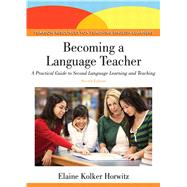
Note: Supplemental materials are not guaranteed with Rental or Used book purchases.
Purchase Benefits
Looking to rent a book? Rent Becoming a Language Teacher A Practical Guide to Second Language Learning and Teaching [ISBN: 9780132489980] for the semester, quarter, and short term or search our site for other textbooks by Horwitz, Elaine K.. Renting a textbook can save you up to 90% from the cost of buying.
Elaine Horwitz is Professor of Curriculum and Instruction and Director of the Graduate Program in Foreign Language Education at the University of Texas at Austin. She was born in Washington, DC, and attended the Montgomery County, MD, public schools where she studied French and Spanish. She began her language teaching career in seventh grade when other students would ask her to explain what her teacher was saying.
Professor Horwitz earned her BA at the University of Maryland at College Park and her MA and PhD in Second Language Learning and Teaching at the University of Illinois at Urbana-Champaign. While there, she was a Title VII Bilingual Education Fellow and supervised foreign language, ESL, and bilingual student teachers.
She first taught French, Spanish, and English in the Prince George’s County, MD, public schools and later went on to teach at University High School in Urbana, IL, and as a Graduate Assistant at the University of Illinois. Before moving to the University of Texas, she taught courses in French, language teaching methodology, and bilingual education at the State University College of New York at Buffalo.
At the University of Texas, Professor Horwitz is Director of the Graduate Program in Foreign Language Education and teaches courses in language teaching methodology, second language acquisition, language testing, and second language research methods. She is well known for her research on language anxiety and student and teacher beliefs about language learning. In addition to numerous scholarly articles and chapters, she is the co-editor with Dolly Young of Language Anxiety: From Theory and Practice to Classroom Implications. Her assessment tools, the Foreign Language Classroom Anxiety Scale and the Beliefs about Language Learning Inventory, are widely used to help teachers and researchers better understand the needs of second language learners. She has been an invited lecturer and consultant on improving language teaching throughout the world.
Preface
Part I • What Do Language Teachers Think About?
1 What Should I Know about Language Learners and Language Teaching Settings?
Types of Language Learning Settings
Learner Characteristics
Younger Learners and Stages of Cognitive Development
Identity and Language Learning
2 What Should I Know about Second Language Acquisition?
Theories of Second Language Acquisition
The Critical Period Hypothesis
How the Theories Differ on Important Language Teaching Issues
Implications for Language Teaching
3 What Should I Know about Language Teaching Methodologies?
Language Teaching Methods
What Is the Best Language Teaching Method?
Content-Based, Sheltered-Immersion, Learner-Centered, and Task-Based Approaches to Language Teaching
From Teacher-Centered to Learner-Centered Approaches
Part II • How Do You Teach a Language?
4 What Should I Know about Teaching Listening?
The Importance of Listening Comprehension
Obstacles to Teaching Listening Comprehension
The Listening Process
Some Guidelines for Developing Listening Activities
Activity Ideas
Assessing Listening Comprehension
5 What Should I Know about Teaching Speaking?
The Importance of True Communication in the Language Classroom
Obstacles to Teaching Speaking
The Development of Speaking Ability
Some Guidelines for Developing Speaking Activities
Activity Ideas
Assessing Speaking
6 What Should I Know about Teaching Reading?
The Importance of Reading
The Reading Process
Types of Second Language Reading
Learning to Read in a Second Language
Types of Reading Materials
Helping Students Develop Effective Reading Strategies
ESL Teachers and Content Reading
Some Guidelines for Teaching Reading
Activity Ideas
Assessing Reading Comprehension
7 What Should I Know about Teaching Writing?
The Writing Process
Types of Second Language Writing
Helping Students Develop Effective Writing Strategies
Some Guidelines for Teaching Writing
Activity Ideas
Assessing Writing
8 What Should I Know about Teaching Academic English in Content Classes?
The Development of Academic Language
Generation 1.5 and Transnational Students
Scaffolding, Contextualized Input, and Thematic Units
Promoting Second Language Development in Content Classes
Academic Literacy 166
Integrating Language Skills Using Thematic Units and Task-Based Activities
Some Guidelines for Teaching Language through Content
Activity Ideas
The Cognitive Academic Language Learning Approach (CALLA)
Assessing Language in Content Classes
Part III • How Do I Know What to Teach?
9 How Do I Assess Language Learning?
Standards
Issues in Language Testing
Testing Approaches
Testing for a Variety of Purposes
Testing the Standards
The TOEFL, the ACTFL OPI, the IELTS, and the TOEIC
10 How Do I Plan My Classes?
Planning for Your Students
Common Language Teaching Activities
Differentiating Instruction and Supporting Learner Autonomy
Part IV • Where Do I Go from Here?
11 So, Am I Now a Language Teacher?
Thinking of Yourself as a Language Teacher
Becoming Open to New Ideas about Language and Language Teaching
Becoming a Better Language Teacher
Your Future as a Language Teacher
Beginning Your Journey as a Language Teacher
Appendix A: The Beliefs about Language Learning Inventory (BALLI ) Revised ESL Version
Appendix B: Foreign Language Classroom Anxiety Scale (FLCAS)
Appendix C: Teacher Foreign Language Anxiety Scale (TFLAS)
Glossary
Index
The New copy of this book will include any supplemental materials advertised. Please check the title of the book to determine if it should include any access cards, study guides, lab manuals, CDs, etc.
The Used, Rental and eBook copies of this book are not guaranteed to include any supplemental materials. Typically, only the book itself is included. This is true even if the title states it includes any access cards, study guides, lab manuals, CDs, etc.